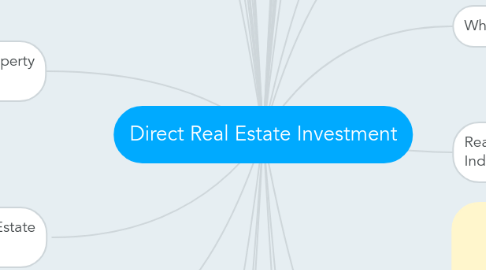
1. tenant demand dependant upon level of general economic activities.
2. consider impact of surplus vacant property
2.1. generally inelastic supply
3. fixed in the short term
4. Planning law
5. Real estate investment implies that property should be treated as a financial asset.
6. Fundamentally, technologically and legally, real estate is a very stable asset class and this is reflected in its low level of volatility
7. There is evidence that real estate return is linked to equity market and interest rate.
8. Impact of leases - e.g. wording of rent review clause
9. In the long term, direct real estate investment is risk diversifier in mixed-asset portfolio and likely to improve risk-adjusted performance of that portfolio.
9.1. But this has to be set against practical issues and obstacles associated with investment in direct real estate
10. Real Estate Investment Types
10.1. Agricultural
10.2. Leisure:
10.2.1. hotels,
10.2.2. cinemas,
10.2.3. pubs,
10.2.4. restaurants,
10.2.5. nightclubs,
10.3. Residential - unpopular for most of post-war era because of impact of legislation but making a comeback.
11. Do valuations accurately reflect traded prices?
12. Characteristics of Direct Property Investment
12.1. Income (Income accounts for about 70% of property total returns in the long run)
12.1.1. fixed for five years
12.2. suffers very little from depreciation due to changes in technology.
12.3. Taxation
12.4. Reliance on property valuations because of heterogeneous nature of property.
12.4.1. Can valuations keep pace with rapidly changing market sentiment?
12.5. Statutory control - e.g. fire regulations
13. Characteristics of Real Estate Investment
13.1. Supply
13.2. Demand
13.2.1. investor demand subject to weight of money, attractions of property as compared to other asset classes and outlook for the market.
14. Real Estate Market
14.1. User market (demand)
14.2. Financial asset (financial market)
14.3. Development market (supply)
15. Investment Return
15.1. Value of a building
15.1.1. Pt=It/Kt
15.1.1.1. P: the price or value of a building
15.1.1.2. I: the net income derived from letting the building
15.1.1.3. K: capitalisation rate*
15.1.1.3.1. considerations make up the capitalization rate:
15.1.1.4. t: in any period
15.2. rate of return
15.2.1. r=(P1-P0+a1)/P0
15.2.1.1. r=rate of return
15.2.1.2. P1 =the price at the end of period 1
15.2.1.3. P0 = the price at the end of period of 0.
15.2.1.4. α1 =the income received during the holding period
15.3. Investors are concerned with their total returns
15.4. Total return is obtained by adding the income return to capital change
15.5. It is generally expressed as a % per annum
15.6. The total return is effectively the internal rate of return
16. investors get vs want
16.1. want
16.1.1. Over-reliance on the UK
16.1.1.1. Concentration on 3 sectors
16.1.2. Predicable/stable income oriented returns
16.1.3. Diversification away from equities (+economic/geo-political)
16.1.4. Some liquidity options (rightly or wrongly)
16.1.5. Skilful asset management
16.1.6. Value for money
16.2. get
16.2.1. Too benchmark focused
16.2.2. Liquidity-when they don’t need it and illiquidity when they do
16.2.3. Fees not always properly structured
17. summary
17.1. Real estate is a major investment market.
17.2. The real estate investment market is very imperfect and property is a complicated investment vehicle because of the fact that is a physical asset.
17.3. The relationship between real estate and other assets varies over time.
18. Illiquid
18.1. lengthy marketing period
19. Indirect investment: invest in property companies or property funds through holding the equity shares
19.1. Dividend
19.2. Changes in share price
20. Core investment types
20.1. office
20.2. industrial
20.3. retail
21. lengthy transaction period
22. full management control
23. one of many Investment Assets
23.1. Equities
23.2. Bonds
23.3. Gilt edged securities (gilts)
23.4. Gold
23.5. Cash
23.6. Currencies
23.7. Paper derivatives
23.8. Works of art
24. transactions can grind to a halt under certain market conditions
25. U.K. lease structure - traditionally 25 years, upward only rent reviews, but now shorter terms and break clauses
26. initial returns may be high
27. What is an Investment ?
27.1. Giving up a capital sum now to receive future monetary benefits
27.2. The monetary benefits may consist of :
27.2.1. capital gain
27.2.2. Property (commercial and residential)
27.2.3. income
28. security depends on tenant covenant strength
28.1. Direct investment involves the ownership of a freehold or long leasehold interest in property.
28.1.1. The benefits are the rental income stream and
28.1.2. any capital appreciation to the investor.
29. Limited ability to switch sectors or move in and out of the market
29.1. The equity market returns lead direct real estate returns.
30. property benefits from long term population growth and restricted land supply and
31. Real Estate Investment Direct vs. Indirect
32. Characteristics of Direct Real Estate Investment
32.1. Physical asset:
32.1.1. Depreciate
32.1.2. fixed location
32.1.3. land and buildings
32.2. limits market participation
32.3. Heterogeneous
32.3.1. possible opportunities
32.3.2. each property is unique
32.4. Large lot size
32.4.1. issues of risk spread
32.4.2. excludes small private investors
32.5. For property the income comes in the form of rent ( normally quarterly in advance)
32.6. Indivisible
32.6.1. but property unit trusts are available
32.6.2. limited partnership vehicles are available
32.6.3. Management intensives
32.6.3.1. cost and skill implications
32.6.4. all or nothing
32.7. High trading costs
32.7.1. stamp duty paid
32.7.2. Capital gains tax (not for REITs)
32.7.3. solicitors and surveyors needed
33. Characteristics of Real Estate Investment Market
33.1. No central market place
33.2. Restricted entry
33.3. Illiquid
33.4. No set price to trade
33.5. Imperfect knowledge
33.6. Trading costs are high
33.7. Difficult to construct a measure of market performance
33.8. The market consists of a number of geographical and type sub-markets
34. Advantages vs. Disadvantages
34.1. AD
34.1.1. ability to add value
34.1.2. high yield
34.1.3. stable income stream
34.1.4. physical asset
34.1.5. low corelation with equities
34.2. DISAD
34.2.1. transaction cost
34.2.2. illiquidity
34.2.3. large lot sizes/lack of divisibility
34.2.4. depreciation
34.2.5. value takes time to materialise
